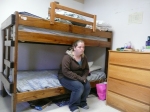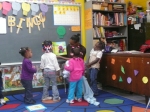How homeless shelters and schools work together to help schoolchildren
Posted: December 3, 2010 in Homeless children - a diffrent kind of testThe South Side Mission – a look into a place dedicated to giving shelter and hope to the homeless.
Posted: November 12, 2010 in Homeless children - a diffrent kind of testThis presentation gives a quick overview of the South Side Mission in Peoria, Ill., and a very brief look into the living conditions and lives of some of its residents. Click on the first picture below to follow the slide show with descriptions.
Map of homeless shelters and the schools close to them in Peoria. Il
Posted: November 5, 2010 in Homeless children - a diffrent kind of test“No child left behind”, not coming through for many.
Posted: October 26, 2010 in Homeless children - a diffrent kind of testArriving for football practice in the early hours before the start of school, every morning the coach would greet the same student who was always there first. The high schooler was eager to play, so the coach thought, and he did not question his presence, until he saw the sleeping bag at the edge of the field.
“That is when I get the call,” said Mary Ellen Ulrich, the lead liaison for homeless students in the city of Peoria and Peoria County. “The kid was sleeping in his sleeping bag. He is part of one of the largest, growing number of students who are homeless.”
According to Ulrich, during the 2009 -2010 school year, in the 18 school districts in the city of Peoria and Peoria County, 562 students were recorded as homeless. Among them, some were living in shelters, living as “doubled-up” while finding refuge in a friend’s of family member’s home, or staying in hotels, motels or trailer parks.
Ulrich’s position is part of the McKinney-Vento bill, which was created by the Bush administration in 2002 and falls under the “No Child Left Behind” act.
The bill federally mandates that there must be a liaison in every regional office of education, states the Illinois State Board of Education’s website (ISBE), who is specifically designated and oversees homeless students in their area. Liaisons make sure these students have a place to stay, have transportation to school and ample school supplies.
The average age for a homeless child in the United States is nine-years-old, and at this age mostly stay within the family unit and live in a shelter while being displaced.
The Salvation Army in Peoria shelters families, has 10 rooms and can house up to 40 people at a time.
“Our children here range from six months to 17-years-old,” said Vicki Bradshaw, a caseworker at the Salvation Army’s homeless shelter division. “Our families usually stay here between three to five months. They are enrolled in school, take a school bus and have family- and after- school support.”
But this is not the case for the growing number of homeless youth, who Ulrich said, are the new face of homeless students.
“Living vagabonds is what they are,” said Ulrich. “They are couch surfers, they are going from a friend tonight to spending the weekend at another friend’s, to maybe sleeping in somebody’s car. They do not have a home base, and they have no one to advocate for them.”
The number of homeless students alone on the street is growing, she said, and the average age of the children is getting younger.
“When I started seven years ago, we counted 83 unaccompanied youth,” said Ulrich. “Last year we had 562. When I first noticed them, four or five years ago, they were basically older high school students, 11th and 12th graders, who, for whatever reason, were being pitched out. Now, the ages are dropping, we are getting a lot of eight or ninth graders with this, who really do not have a parent in charge.”
Linda Butler, minister and director at the South Side Mission in Peoria has also seen an increase in young teens living on their own.
“Up until a couple of years ago, we hardly ever saw young teens without a parent, completely on their own,” said Butler. “And this year, at the beginning of the school year, we had eight minors, and two adult age teens needing a place to stay.”
It is heart breaking, she said, and the situation is made even more difficult by the South Side Mission’s rule which does not allow boys over the age of 13 to live in the shelter.
“We have a hard time turning them away,” said Butler. “We always make sure they leave here with a referral or contact number.”
The liaison is often the only person the teen can turn to, but that may change also if the funding for Ulrich’s position is not re-approved.
Ulrich said, that even though the federal government has allocated the money to Springfield, as of Oct 1, legislatures there have not delegated the funds needed to maintain her position and leaves the future, for those who need her services, even more uncertain.
Right now, she said, she is just a “smoke person with no cloud” but still goes into the office and works on the “hardest cases that need attention immediately.”
“The kids need us now, not in May,” said Ulrich. “They need our services right now to get through the school year.”
The numbers are under reported, said Ulrich, and the real number is closer to 6 percent of all students.
“We have a huge population, huge number of unaccompanied youth,” said Ulrich. “Those are the kids who have no one to advocate for them.”
She will continue to advocate, she said, funding or no funding.
“I am an educator and value the kids. I believe in what I have done, it is not something that I sit around in the garden and just talk about,” said Ulrich. “I believe in helping these kids. Sleeping in a sleeping bag by the football field is not acceptable.”
Homeless students not the only one affected by state budget cuts
Posted: October 4, 2010 in Homeless children - a diffrent kind of testThe state legislatures hold the purse strings, and by cutting or not releasing monies due to schools, it is putting schools and students into jeopardy, says Mary Ellen Ulrich, Peoria school bard liaison for homeless students.
“Every aspect of school is being affected by the state legislatures not giving our budgets out,” said Ulrich. “They are just sitting on this money. They say, all our funds are being cut this year, and truancy for example is not a high enough priority. We think, they are just waiting for the elections.”
Money, which has been allotted by the federal government, is being held back by the state, awaiting votes and decisions to be distributed to local school branches. Usually, these monies come through at the beginning of the school year, but as of Oct,1 many educators, social workers and case workers are still waiting to find out if they have a job, and Peoria area students are not receiving the services they need to be successful in , or even just going to school.
“The truancy position has been completely cut, no one is following up on these kids” said Ulrich. “So have reading coaches, teachers aides and library positions. It just go across the board.”
Manual High School, as a whole, was one part of the school system which fell victim to budget cuts. It was closed at the end of the spring 2010 school year, and the repercussions are being felt with the upstart of the fall semester.
“600 students had to be dispersed among other schools,” said Ulrich. “What it did in saving money by closing that school, is now having to be made up otherwise, with hiring more security and facilitating overcrowded classrooms.”
Ulrich says, that six positions in the homeless division alone have been cut, and that she is coming in on a voluntary basis, without being paid but feeling a moral obligation to do so.
“I have been in education since 1968, and in my opinion people are making decisions out there who do not have the facts or do not know what they are talking about,” said Ulrich. “One of the most important commodities we have are the children and their education. These legislatures are letting these children, and us as a society, down.”
Funds once designated and then cut, are also half-halfheartedly promised to be returned, next year, or after another election, but Ulrich does not buy it.
“Once money is taken away, it wont be given back,” Ulrich said. “It will be already spent on something else.”
Homeless Children and School: A much harder kind of test.
Posted: September 21, 2010 in Homeless children - a diffrent kind of testWith the start-up of the new school year, many parents are worrying how their children will do in school. But for a growing number of parents the worry is if their children will be going to school at all.
The economic downturn in the Unites States has affected many, and on many levels. Loosing a job, making personal cutbacks or having to declare bankruptcy are just some of the situations many Americans are having to deal with. In most cases, it is a temporary setback, but what if a family looses everything, including a place to live?
The displacement of a family has far-reaching ramifications; the possible lack of continuation of a child’s education is one of them. What are the options for children once they lose the stability of a steady home environment, do they attend school, if so, where? And if they do, how do these kids cope with getting to school, doing their homework and the social stigma of being a homeless person? And for the long-term, how does this unstable situation play into their educational success?
The Illinois Department of Education defines homeless students , among other criteria, as “children and youth who are sharing the housing of other people due to loss of housing or economic hardship, are living in hotels, motels or trailer parks due to lack of alternative adequate accommodations, are living in emergency or transitional shelters, or are living in cars, parks,public spaces and abandoned buildings”.
According to a report released in July 2010 by the National Association for the Education of Homeless Children and Youth (NAEHCY), and published by the World SocialistWebSite (WSWS), the numbers of homeless students in the public school districts around the nation have risen drastically, increasing 40percent from 2006 until 2009, bringing the total to 956,914 children who do not have a place to call home.
An article published in 2008 by the Peoria Journal Star states, that “during one night, Jan.29 of this year, officials counted 342 people living in local shelters or transitional housing”, and that “throughout the last year there were 847 homeless individuals using service programs in the Peoria area”.
During the same year, the Illinois State Board of Education announced, that 60,000 homeless students lived in the state of Illinois, and, as the Daily Illini reported, “The Champaign-Urbana area had 192 homeless students last year, an increase from 188 homeless students reported in 2006 and 59 in 2005.”
Homeless shelters, such as the South Side Mission and the Center for Prevention of Abuse in Peoria give individuals and families a safe place to stay and a chance to reorganize their lives by maintaining some sort of stability.
They also work closely with the Illinois State Board of Education to inform homeless students, their families and the schools about homeless education rights. Many homeless parents may worry that their children will fall between the cracks, that school may not be an option in their current situation because of the lack of a permanent address.
But according to the ISBE’s website, “The Illinois State Board of Education (ISBE) is working with the state’s homeless shelters to eliminate the barriers homeless students face in getting access to public education. ISBE is in the process of distributing approximately 2,000 question and answer booklets this summer to the state’s homeless shelters so that they will be able to work with homeless families to enroll their children in public schools this coming fall”.
With their attendance in school assured, how do these kids deal with the challenges and attached social stigmas? Living in a homeless situation adds emotional stress, and kids may be more prone to anxieties caused by lack of sleep, lack of adequate nutritious meals and the feeling of being different and alienated from their classmates due to their status. Often these children do not receive adequate medical care and, because of their own worries, not enough support from their parents regarding their schoolwork. Homeless children are prone to not attending school regularly, which is only a detriment to their grades and academic performance, and maybe a precursor to dropping out of school.
An article published by the National Association of School Psychologists says, that “overall academic achievement of homeless students is poor, that 43 percent repeat a grade, 25 percent are placed in special education and 50 percent are failing academically.
The Illinois State Board of Education states in its website, that it considers the enrollment, attendance and success of homeless children and youth in Illinois a priority, but with the economic recovery not yet on the horizon, and the number of homeless families likely to rise, the ISBE, the welfare and homeless shelters, and all the other helping hands have their work cut out for them if they are to receive high grades for helping this part of the population graduate.











